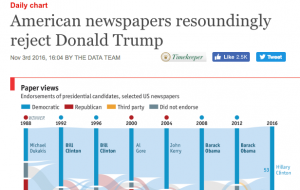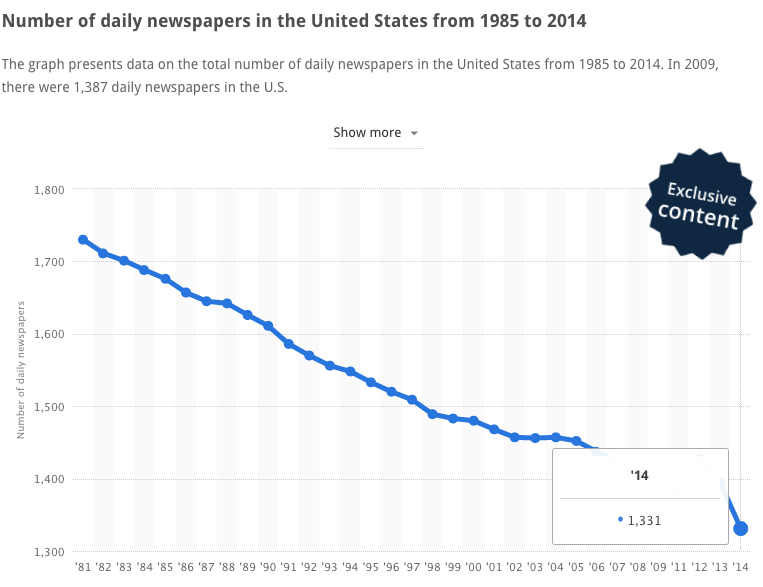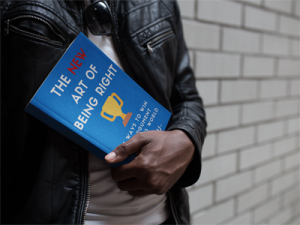By Min Liu | Verbal Skills
As of today, the 2016 elections are right around the corner. Personally, I don’t find any of the choices for president particularly appealing and this issue has been written about endlessly by others, so this article will not focus on the merits (or lack of merit) of any particular candidate.
Instead, this article focuses on something much more interesting to this blog’s readers, which are the debate tactics people use to debate each other about political issues and candidates. In this article, you will learn the most common dirty debate tactics that you must know in order to defeat your opponents!
Let me give you an example of a “dirty trick” right off the bat.
When I wrote this article, I saw this headline from the Economist:

Sounds like all (or most) American newspapers reject Trump and have endorsed Hillary, right?
So, I was curious how many newspapers were actually surveyed.

It turns out 72 “selected” newspapers were surveyed. That’s a lot of newspapers, right?

It turns out that in 2014, there were 1,331 newspapers in America! There are less today for sure, but certainly many more than 72.
72 out of 1,331 is only 5% of the newspapers in America!
I’m no statistics expert, but even my layperson brain tells me this is hardly “resounding”.
Now, my point is not to dispute this “fact”. This “fact” may very well be true, but you cannot reasonably survey only 5% of the newspapers and make this conclusion. (In fact, the two biggest newspapers where I live, the San Francisco Chronicle and the San Francisco Examiner were not included in the list of 72).
This is an example of the dirty debate tactic of “cherrypicking”.
A fancy phrase for these dirty debate tactics is “logical fallacies“.
As for me, I’m not one for fancy pansy phrases.
I prefer to call them “dirty tricks”.
Dirty tricks that people use, consciously or not, in order to advocated for their preferred candidates or positions and against others’ preferred candidates or positions.
These are dirty tricks because they are methods people use in order to avoid using logic and facts in a political debate (or any debate actually).
If you want to debate politics, which is debatable whether you should even do that, then you must learn these debate tactics aka dirty tricks, so that you can use them yourself.
Okay, I’m just kidding about that, but you must learn these dirty tricks so that at a minimum, you do not get fooled, tricked, or bamboozled by them.
And, even if you want nothing to do with a political debate, you can learn something from this article. These debate tactics are applicable to all walks of life and all situations where people argue or debate over something.
So, here we go. Here’s my quick and dirty guide to five dirty political debate tactics, which you can see in this video:
The first dirty trick is what I call “sneaky” ad hominem attacks.
We all know that ad hominem attacks are part and parcel of debates about political candidates. Always expect and anticipate them!
Ad hominem attacks have nothing to do with facts or logic.
You should always expect others to attack your preferred candidate with mostly irrelevant things about their personality or person. Like Trump’s hair. Or, that time Hillary fainted. You should always be on the lookout for these types of attacks because they are irrelevant.
However, what I mean by “sneaky” ad hominem attacks is something a little bit different:
“Sneaky” ad hominem attacks are used to discredit a candidate or maybe a source of factual information, i.e. using a label to distract from the underlying factual information.
An example would be giving a source a label such as “alt-right”, as if being “alt-right” means they can never be right. Just because a source of information is “alt-right” doesn’t mean that the information is incorrect. The same thing applies to other labels.
Another kind of “sneaky” ad hominem attack is an attack on you personally, usually when you bring up a good point on a political issue. Here’s an example: “I can’t believe you support that issue (or candidate)” or “I just lost some respect for you when you said that”.
Incredulity doesn’t mean that your point is not correct! Shaming you is also not a legitimate debate tactic!
The second dirty debate tactic is the use of double standards or shifting standards.
What I mean by double standards or shifting standards is that negative facts are only negative when they’re about the other side.
Whenever negative facts relate to your opponent’s side, you will find that the standard (and one that is artificially high) they hold your candidate to suddenly disappears. Or, the standards that get applied to their preferred candidate get shifted or changed (always lower or non-existent).
Be vigilant for this dirty trick!
The third dirty debate tactic is the use of ambiguous or vague sources, evidence, or facts.
Your opponents will use all sorts of anonymous sources (or use sources that quote anonymous sources) in an attempt to prove their points. Do not trust anonymous sources. If you cannot verify who said something, then it might as well be made up, and in fact, it often is made up.
Or, they will use ambiguous sources. An example: “Media outlets have looked into this and debunked it”. Or, “all the experts agree”. Which media outlets (or experts) and what specific facts did they give? Even if many specific media outlets or experts are given, what biases do these outlets have?
Even named sources cannot be trusted. Assume that most media has been spun to “prove” a certain point. You cannot always be sure that what the media reports is actually true. Again, what biases or conflicts of interest do they (or their owners) have?
And sometimes, even sources, evidence, and facts may be misrepresented in order to prove a point. Don’t just think about what they’re telling you. Make sure you think about what they’re NOT telling you.
Don’t just think about what they’re telling you. Make sure you consider what they’re not telling you.
A subset of this dirty debate tactic is the use of “social proof”, such as “so and so said this”.
Usually, the person saying something is a celebrity or someone well known. However, just because somebody famous said something or believes something, doesn’t make that thing a fact!
The fourth dirty debate tactic is the broad area of what I call “knowledge” (and I”m using quotes on purpose).
Often, you will find people stating their beliefs and characterizing them as fact.
Your opponent’s belief is NOT fact.
What they “think” is NOT fact.
A sneaky way people use this technique is to say something like “I can’t imagine Hillary doing this or that.”
What someone “imagines” is also NOT fact.
Or, you will find people putting themselves into a candidate’s shoes and arguing about their “intent”. The problem is, no one can ever know about somebody’s intent.
This type of “knowledge” is not actual knowledge. They aren’t facts. They aren’t real, and you should never be fooled by it.
The fifth dirty debate tactic is the use of irrelevant analogies and metaphors.
Don’t get sucked in by analogies and metaphors that sound good.
As I have reiterated in the past, using analogy and metaphor is an incredibly powerful persuasion tool, and so on the flip side, it is very easy to get sucked into and be defeated by an analogy or metaphor.
Some people know that analogies and metaphors are powerful persuasion tools (including me), so they will seek to use them against you in the hopes that you will not realize it or that you will not know how to defeat it.
However, you need to realize that an analogy or metaphor, no matter how good it sounds, may not have any actual application to the real, literal issue at hand, so make sure you keep a keen eye on this tactic and look to differentiate analogies from the issue at hand where they are not relevant.
So there you go, those are the most common dirty debate tactics that people use in political debates or “discussions”. Keep an eye out for them and never get fooled again!
If you want to learn more about the dirty tricks people use in arguments or debates (not just in political debates, but any type of debate), check out my book The New Art of Being Right: 38 Ways To Win An Argument In Today’s World. 
Inside, you will learn 38 of the most common and time-tested methods people use to win debates and arguments. Don’t ever be fooled again!
Click HERE to get a free preview of The New Art of Being Right: 38 Ways To Win An Argument In Today’s World.